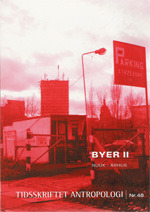TEHERAN
DOI:
https://doi.org/10.7146/ta.v0i48.107096Resumé
In this article it is argued that Tehran itself
as well as the Iranians’ conception of
Tehran is changing. The size of Tehran,
the capital of Iran, has within a few
decades risen explosively from no more
than 300.000 inhabitants in the 1930s to
more than 9 million people today. At the
same time the city has experienced a
radical demographic divide between the
lower, warmer, poorer and more traditional
South and the richer, more modern
North close to the cooler mountains. The
conception of Tehran today is that of “a
modern part” of Iran; i.e. North Tehran.
While everybody agrees that Tehran is
modern, the significance of this modernity
is vehemently debated. The technological
and financial aspect of Tehran’s modernity
is unanimously seen as a positive feature,
whereas the individualistic aspect of this
modernity to some Iranians is seen as a
moral threat to society, while others see it
as a liberalising and positive force in
society. In other words Tehran has become
the battlefield of morality where “true
Islam” meets “modern corruption”, “true
Iranianism” meets “Western decadence”
etc. And nowhere is this seen more
explicitly than in the parks of Tehran. The
urban parks have within the last decade
developed into semi-private spaces partly
free of government control, neighbours’
gossip and family restrictions. The culture
of the private space (the home) has thus
been moved into the public space, and at
the same time this transformation causes
the emergence of the modern, secularised
urban individual, which to some extent
demands separation of religion and state.
This urban individual can no longer be
controlled by the local priest and cannot
be restricted from receiving news and
viewpoints from outside of the national
state-controlled media. Tehran has in this
way become a physical and symbolical
battlefield, where the dialectical and often
contradicting moral consequences of
modernity are being negotiated, restricted
and craved.
Downloads
Publiceret
Citation/Eksport
Nummer
Sektion
Licens
Ophavsretten til artiklerne i Tidsskriftet Antropologi tilfalder forfatteren.
Artikler publiceret i Tidsskriftet Antropologi må citeres, downloades og videresendes for ikke-kommerciel brug, under forudsætning af normal akademisk reference til forfatter(e) samt tidsskrift, årgang, nummer og sider. Artiklerne må kun genudgives med eksplicit tilladelse fra forfatter(e) og tidsskriftet.


